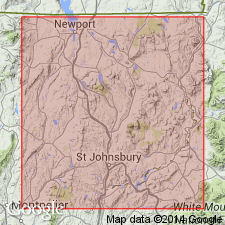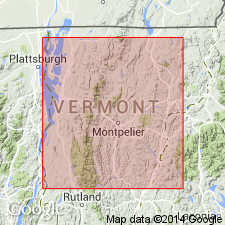
- Usage in publication:
-
- Lunenburg schist*
- Modifications:
-
- Original reference
- Dominant lithology:
-
- Schist
- AAPG geologic province:
-
- New England province
Summary:
Pg. 79-82. Lunenburg schist. Highly metamorphic green, greasy, chlorite schist. [Pre-Cambrian on p. 79-80; probably Cambrian, p. 80; on p. 82 is following:] Prof. Hitchcock suggested, in "Geol. sections crossing New Hampshire and Vermont" term Montalban as = White Mountain series in New Hampshire, whose age is late Laurentian. In this report I have included these with Lunenburg schist as pre-Cambrian, awaiting further field investigation.
Source: US geologic names lexicon (USGS Bull. 896, p. 1237).

- Usage in publication:
-
- Lunenburg group
- Modifications:
-
- Revised
- AAPG geologic province:
-
- New England province
Summary:
Table opp. p. 288. Lunenburg group. Uppermost Upper Cambrian of eastern Vermont, consists of sericite quartzite, sericite schist, and chlorite schist.
Source: US geologic names lexicon (USGS Bull. 896, p. 1237).
For more information, please contact Nancy Stamm, Geologic Names Committee Secretary.
Asterisk (*) indicates published by U.S. Geological Survey authors.
"No current usage" (†) implies that a name has been abandoned or has fallen into disuse. Former usage and, if known, replacement name given in parentheses ( ).
Slash (/) indicates name conflicts with nomenclatural guidelines (CSN, 1933; ACSN, 1961, 1970; NACSN, 1983, 2005, 2021). May be explained within brackets ([ ]).

